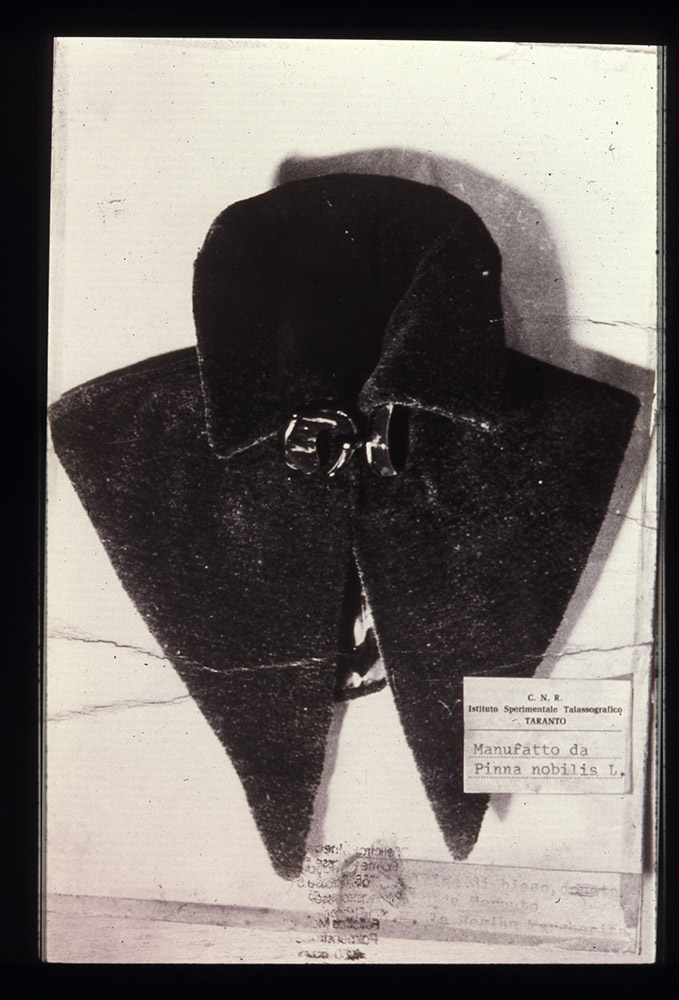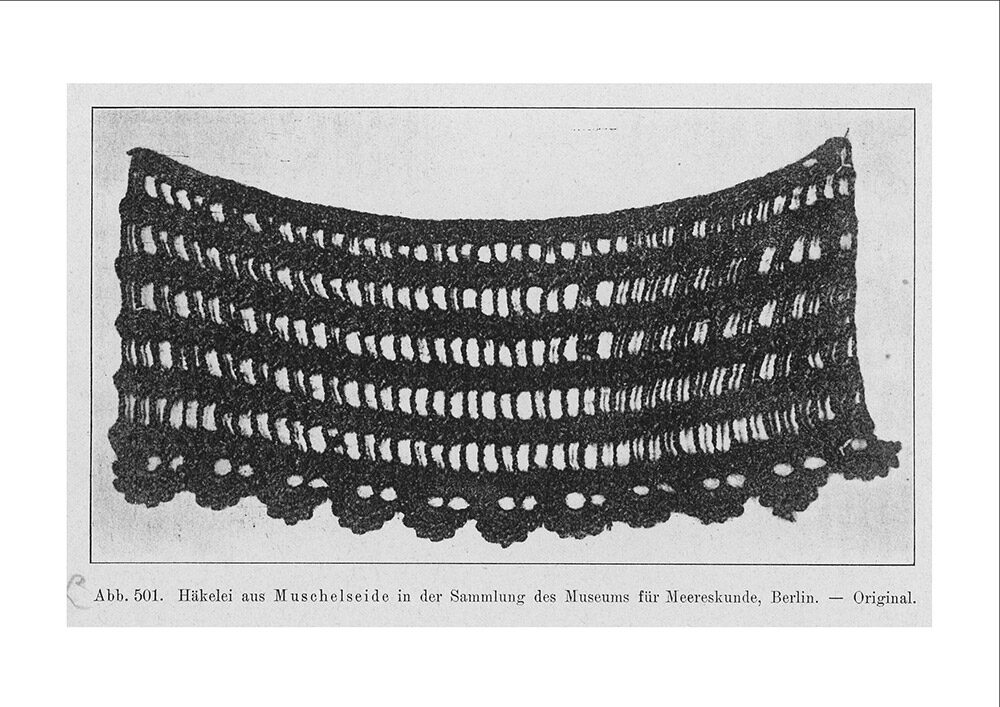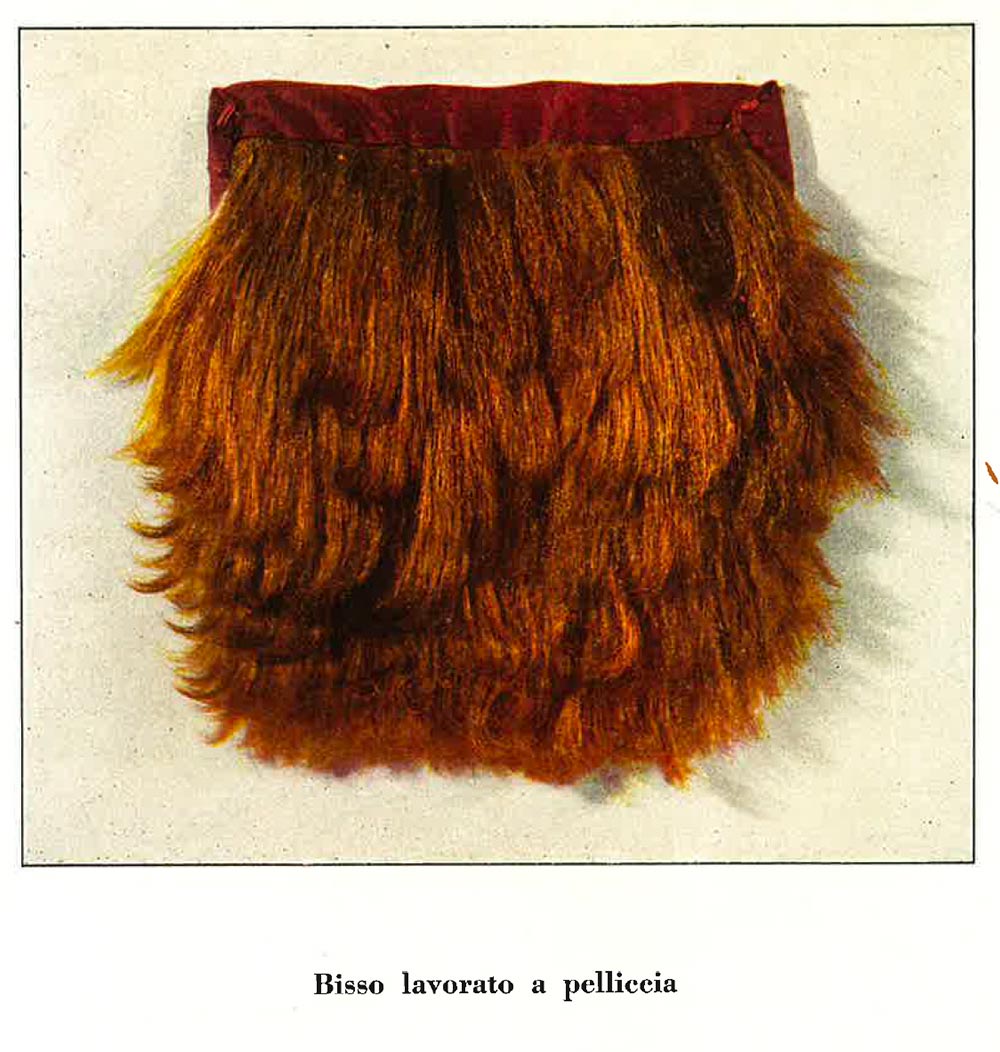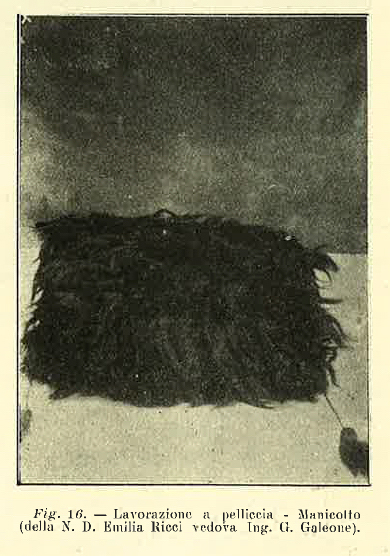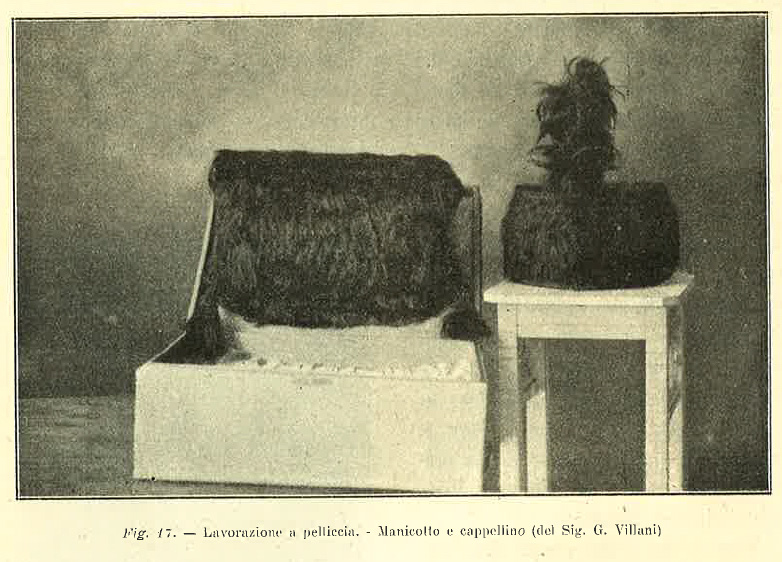Potential objects
Many objects made of sea silk are known from literature. Until recently, the tapestry for Pope Leo XIII was one of them, which – thanks to this homepage – has now been discovered.
There are photographs of other objects in publications. These have not yet been found. Were they destroyed by moths, thrown away by the heirs, or are they lying – still unrecognized – in some attic, or in some collection of old textiles? Some of them will be presented here in the hope that this may provide clues to their history or whereabouts. Every tip, no matter how small, can be important! Please report to felicitas.maeder(at)muschelseide.ch Thank you!
Objects handed down from visual sources
Mantilla, end 19th century, I-Taranto. I-Taranto , Istituto Sperimentale Talassografico (MS Inventar PB 1)
Label: “Manufatto da Pinna nobilis L. „Mantellina di bisso, donato da Taranto a S.M. la Regina Margherita”
“E su per giù il medesimo intendimento avevano …. e la ricca mantellina donata alla compianta Regina Margherita.” (Mastrocinque 1928, p. 11)
“… e una stupenda mantellina per la Regina Margherita” (Acquaviva 1980, p. 51)
“In occasione della visita dei Reali d’Italia, fu confezionata una mantellina data in regalo alla Regina Margherita di Savoia, di cui si conserva la fotografia.” (Pastore 1998, Brf. 18.2.98 an FM)
“L’elenco dei manufatti in bisso marino di cui oggi si ha ricordo – proprio perché offerti a personaggi famosi – comprende pure una mantellina donata alla regina Margherita di Savoia, consorte di Umberto I, in occasione di una visita ufficiale a Taranto forse nel 1889. Lavorata con una tecnica chiamata a pelliccia (l’altra è detta a filo), in quanto i ciuffi di lanapinna vengono cuciti accostandoli gli uni agli altri, secondo strati successivi, della predetta mantellina oggi a Taranto si conserva la fotografia in una bacheca del C.N.R.- Istituto ambiente marino e costiero – sez. di Taranto (un tempo Istituto sperimentale talassografico).” (D’Ippolito 2004)
Crocheted fragment, formerly Museum für Meereskunde, Berlin (MS Inventory PB 2)
Sea silk crochet in hole pattern and semi-circular border decorations, according to Brühl 1938 in the collection of the Museum für Meereskunde, Berlin (Brühl 1938, Fig. 501, p. 987)
The Museum für Meereskunde MfM was founded in 1900 as an institution of the Berlin University. After heavy destruction in the Second World War, a large part of the preserved exhibition objects was on loan from the Humboldt University to the German Museum of Technology; some objects are also to be found in other places or were lost during the post-war turmoil.
Collar a pelliccia, 19th/20th century, Taranto, in Mastrocinque 1928, Tav. VI (MS inventory PB 3)
Lavorazione del bisso a pelliccia, made with long fibre beards, on shimmering gold-coloured fabric
Bisso lavorato a pelliccia, 19th/20th century, I-Taranto, in Mastrocinque 1928, 4th page (no page reference) (MS inventory PB 4).
Fur-like processed fibre beards, on dark red ground fabric.
Fur muff with two fibre beard, 19th/20th century, I-Taranto, in Mastrocinque 1928, p 39: “Fig. 16. – Lavorazione a pelliccia – Manicotto (della N. D. Emilia Ricci vedova Ing. G. Galeone)” (MS-inventory PB 5)
Fur muff und cap a pelliccia, 19./20. Jahrhundert, Tarent, in Mastrocinque 1928, p. 40: “Fig. 17. – Fur processing. -Sleeve and cap (by Mr G. Villani)”, (MS-inventory PB 6 und PB 7).
Muff with two fibre beard at each side, Cap with a feather-like decoration on top
Objects handed down in written sources
Stockings for the Royal Society London
The first mention of a textile object made of sea silk in England dates from the early 18th century: Stockings made of sea silk, which John Busby (1765-1857) donated to the Royal Society in London on 14 19 May 1719. The fibre beard of the Pinna marina was mentioned as early as 1711. La Royal Society had been founded in 1662 and is thus the oldest erudite society – today the Academy of Natural Sciences.
“The Journal Book indicates that Hans Sloane presented six select items to the Society on 18 October 1711 from Henry Newton, who had been elected a Fellow in 1709 while he was British envoy to Florence; because the time for his admission had elapsed, he was re-elected for admission on this occasion. His fifth object was ‘The Byssus or Beard of the Pinna Marina mentioned by Rondeletius of which the Vestes Byssine and silk of the Antients was made’. […] The Journal Book records that on 14 May 1719 he [John Busby (F.R.S., 1719)] presented the Society with: a Stocking resembling Soft Silk made of the beard of the Shell fish Pinna together with some fragments of the Shell and an Account of it was read. In which by his Own Order at Tarentum in the Kingdom of Naples from the Beards which he Saw taken from Several Shells of a Ffish which much frequents that Branch of the Sea leading to the Bay of Tarentum called Mare De Pesco. The Fish is Called by Some of the Inhabitants the Scooda and by others the Parachella.” (Appleby 1997)
Gloves and/or stockings for Pope Benedict XIV
Almost no historical object made of sea silk is mentioned in literature as often as a gift from 1754 to Pope Benedict XIV (1675-1758): mostly gloves, sometimes stockings. The first mention comes from the British historian Edward Gibbon (1737-1794) in his work on the decline and fall of the Roman Empire, from 1766: “They were still more intimately acquainted with a shellfish of the Mediterranean, surnamed the silk-worm of the sea: the fine wool or hair by which the mother-of-pearl affixes itself to the rock is now manufactured for curiosity rather than use; and a robe obtained from the same singular materials was the gift of the Roman emperor to the satraps of Armenia” – but only in the footnote 66: “Procopius de Aedif. 1. iii. c. 1. These pinnes de mer are found near Smyrna, Sicily, Corsica, and Minorca; and a pair of gloves of their silk was presented to Pope Benedict XIV.” (Gibbon 1766, reprint 1879, vol. IV, p. 173)
– How did Gibbon know about this gift? Had he heard about it on his Grand Tour during his visit to Rome in 1764? He had converted to Catholicism in his youth, although he reversed this less than two years later. Did this result in a contact with the Vatican?
Gibbon thus speaks of stockings; the next mention, from the same year, already speaks of gloves or stockings: “Ne fu presentato un paro di guanti o di calze, come una singolarità pregevole, al pontefice Benedetto XIV” (Pagnini della Ventura 1766, Pignotti 1843). The book by Pagnini della Ventura refers to a trade book from the Middle Ages: Pratica della mercatura by Francesco Balducci, around 1340. Who is referring to whom?
Since the beginning of the 19th century, only stockings have been referred to: “Some stockings of this material were presented, in the year 1754, to pope Benedict XIV, and, notwithstanding their extreme fineness, were found to protect the legs alike from cold and heat.” (Browne, D.J. 1832: The Naturalist, 275-286)
“In the year 1754 a pair of stockings, made of it, were presented to Pope Benedict XV (sic!), which, from their extreme fineness, were enclosed in a small box about the size of one for holding snuff.” (Simmonds 1883, p. 308)
(Simmonds 1883, p. 308) On the legend about the “stockings – or gloves – in the snuff box” see chapter Handicraft aspects → Further processing
“Le fonti scritte ricordano che nel 1754 fu donato al papa Benedetto XIV un paio di calze confezionate a Cagliari col prezioso bisso marino” (Basso-Arnoux, 1916: 5).
“… le calze donate nel 1754 a papa Benedetto XIV” (Falconetto 1921, p.145)
“En 1754, le pape Benoît XIV se vit offrir une paire de bas confectionné avec ladite matière à laquelle on accordait le mérite de pouvoir préserver aussi bien des inconvénients de la chaleur que des atteintes du froid.” (Algoud, 1930, p. 173)
“Von der Feinheit des Materials zeugt die Mitteilung, dass das auf S. 977 erwähnte Paar Strümpfe aus dem Besitz des Papstes Benedikt XIV in einer gewöhnlichen Schnupftabakdose Platz finden konnte” (Anonym 1835), (Brühl 1938, p. 98)
“Papst Benedikt XIV. hat (1754) ein Paar Strümpfe aus Muschelseide besessen, die gleich gut gegen Kälte und Hitze gewesen sein solle.” (Anonym 1835), (Brühl 1938, p. 977)
“… and in the year 1754 a pair of stockings was presented to Pope Benedict XV (sic!). So fine were they that the gift was enclosed in a silver snuff box.” (Cameron 1961)
“In 1754, a pair of sea-silk stockings was presented to Pope Benedict XV.” (Abbott 1972, p. 184)
“1745 (sic!) bekommt Papst Benedikt XV (sic!) ein Paar Strümpfe aus Seeseide. Sie sind so fein, dass sie in einer silbernen Schnupfdose Platz finden. ” (Berger 1983)
“Nel 1754 fu donato a papa Benedetto XIV un paio di calze fatte a Cagliari col prezioso bisso. ” (Carta Mantiglia 1997)
“Although it has not been verified, several writers claim that Pope Benedict XV was
presented with Pinna byssus stockings in a silver snuffbox during 1754. ” “Letter of 29 May 1996 from Fr. Josef Metzler, O.M.I., Prefect of the Vatican Secret Archives, disclaiming any personal knowledge of the gift to Pope Benedict XV (sic!)” (Appleby 1997, p. 34, Anmerkung 21)
Enquiries in 2001 in the Vatican at the Monumenti musei e gallerie pontifiche directorate and at the Fabbrica di San Pietro revealed that neither the receipt nor the whereabouts of these stockings or gloves can be confirmed.
1804: Gloves for Emma Hamilton
Another much quoted object are gloves, which Admiral Nelson sent to his mistress Emma Hamilton in 1804, during his stay in Sardinia.
“Sheltered by Caprera, La Madelena, and Santo Stefano, we find the fine anchorage of Mezzo Schifo; the town of La Madelena, for which we are steering, lying about half a mile south-west of the anchorage. This harbour, named by Lord Nelson “Agincourt Sound,” was his head-quarters while maintaining the blockade of Toulon, from 1803 to 1805. He formed the highest opinion of its position for a naval station, as affording safe and sheltered anchorage, and ingress and egress with any winds. His public and private correspondence at that period shows the importance he attached to its possession, and his anxiety that it should be secured permanently to the crown of England.” (Forrester 1861).
“On 18 March 1804, Nelson, on board the Victory, while blockading the French off Toulon, sent Emma Hamilton: a comb, which looks handsome, and a pair of curious gloves; they are made only in Sardinia of the beards of mussels. I have ordered a muff: they tell me they are very scarce, and for that reason I wish you to have them.” (Semeraro 1964, pp. 4-13, Appleby 1997, p. 30).
Whether Emma ever received this muff is not clear: “Victory, August 20th, 1804. MY DEAREST EMMA, The Kent left us three days ago; …. I have not yet received your muff; I think, probably, I shall bring it with me.” (p. 65: LETTER LII.)
Textiles from Italo Diana in Sant’Antioco
From the first half of the 20th century, a saddle bag and un saio (cowl? scapular?) are mentioned, both from the Scuola di tessitura Italo Diana: “Si sa soltanto che nel laboratorio furono tessute due bisacce di bisso marino per un proprietario di Teulada, un manto per il simulacro di S. Francesco d’Assisi ed un mantello per la Regina.” (in English: We only know that in the workshop two sea silk saddlebags were woven for a Teulada owner, a cloak for the simulacrum of St. Francis of Assisi and a cloak for the Queen.)
Emma Diana also remembers this in the biography of her father Italo Diana: “un saio per la statua di San Francesco nella Chiesa di Assisi”, (“a habit for the statue of St. Francis in the Church of Assisi”.
“… e una mantella per la Principessa Mafalda di Savoia” (Biography Italo Diana da Emma Diana 2010), (in English: and a cape for Princess Mafalda of Savoy). Mafalda (1902-1944) was the daughter of the Italian King Vittorio Emmanuele III and of his wife, princess Elena of Montenegro.
Giuseppe Capecelatro, the great promoter of sea silk
“Nach Tische wurde das Gespräch über Calabrien und dessen Erzeugnisse fortgesetzt. Der Erzbischof macht mir bei dieser Gelegenheit ein Geschenk mit einem Paar Handschuh von brauner Farbe, deren seidenartigen Stoff ich nicht kannte; er heisst Byssus, und findet sich an einem Muschelthiere des Meeres, Pinna marina genannt. ” (Von der Recke, 1815) (in English : After tables, the discussion continued on Calabria and its products. On this occasion, the archbishop gave me a gift with a pair of brown gloves, whose silky fabric I did not know; it is called Byssus, and is found on a mollusk animal of the sea, called Pinna marina.)
In the correspondence between Giuseppe Capecelatros and his vicar Antonio Tanza, who had assumed episcopal duties in Taranto, we find several orders for garments made of sea silk: in 1802 “una camisciola di lanapinna ed un paio di calzette dell’istesso genere” for a marchese Taccone, in 1804 four pairs of man’s and two pairs of women’s gloves “di lanapesce” and twelve “berrettini sfioccati” (? ), in 1805 six man’s gloves and four women’s gloves “di lanapinna” – the size was enclosed as a paper pattern – as well as twelve pairs of man’s gloves” di lanapinna travagliati con qualche maggiore delicatezza” and six pairs of long women’s gloves, which were to be executed with the greatest care as they were intended for the court of St. Petersburg (Vacca 1966).
Scawl, tapestry, muff, gloves, boa…. from Taranto
“All’Esposizione di arti e manifatture di Napoli del 1853 furono inviati, ad esempio, due lavori in bisso marino provenienti dall’Orfanatrofio S.Filomena di Lecce, diretto dalle suore della Carità. Si trattava di un tappeto quadrato per tavolino, tutto lanapinna, con dei piccoli trapunti in seta agli angoli e di un manicotto. Questi lavori ricevettero dalla giuria dell’Esposizione la medaglia d’oro [Annali civili del Regno delle Due Sicilie, vol.XLVII, fasc.XCVII (set.-ott.1853), pp.80-81; ibid. vol.XLVIII, fasc.CI (mag.- giu.1854), p. 80].
“Il bisso marino è presente anche nella I° Esposizione Sarda, tenutasi a Cagliari nel 1871. Da Michelina Cara di Cagliari furono presentati: bisso serico di pinna marina cardato, filato e pronto a tessere, un quadretto contenente in rilievo due cagnolini sotto un albero, lavoro in bisso serico di nacchera e un boà ed un manicotto fatti con bisso serico di pinna marina e da Marianna Randaccio di Cagliari uno sciallo formato in bisso serico di nacchera. Fra i «Prodotti marini utili in diverse arti e lavori», vennero esposti un esemplare di Pinna squamosa del Mediterraneo, appartenente a Gaetano Cara, Direttore del Museo Universitario di Cagliari e perle bianche e rosse (Atti del Comitato direttivo della prima esposizione sarda, 1871: 147 e 150-151; Carta Mantiglia 2004)
„Nel 1873 per l’Esposizione Universale di Vienna, i membri della Giunta speciale di Terra d’Otranto, cioè Luigi De Simone e Gaetano Passaby di Lecce, il barone Domenico Sebastio di Santacroce di Taranto, decisero l’invio in quella città di alcuni manufatti in lanapinna, la cui materia prima veniva da Gallipoli, Nardò1 e Taranto. La signora Giuseppa Romano-Gatto di Galatone aveva confezionato un boa (lungo m.4,19), un tessuto (l.5,25x h.1,00), un manicotto, 4 paia di guanti, una mantella foderata di raso bianco. Quest’ultima fu poi donata dal Passaby all’imperatrice d’Austria. I manufatti provenienti da Taranto, lavorati dalla signora Raffaela Spartera erano: un manicotto, dei polsini ed una mantella, donata alla duchessa d’Aosta“ (de Simone 1873, p.12; D’Ippolito 2004)
An enquiry to the director of the Vienna Museum Wagenburg, which holds the collection of personal objects of Empress Elisabeth, gave no indication of the whereabouts of this white satin-lined mantella: “Es gibt meines Wissens keine Kleiderinventare der Kaiserin Elisabeth – ich wäre selbst froh, wenn eine solche Quelle verfügbar wäre… Das fragliche Kleidungsstück war wohl ein Cape, das mit weißer Seide gefüttert war. Die meisten authentischen Kleidungsstücke der Kaiserin befinden sich in unserer Sammlung, aber ein solches Cape ist nicht darunter.“ (in English: To my knowledge there are no inventories of Empress Elisabeth’s clothing – I would be happy if such a source were available myself… The garment in question was probably a cape lined with white silk. Most of the empress’s authentic garments are in our collection, but there is no cape of this kind among them.)
1873: Shawl for the Spanish queen, Principessa della Cisterna (1846-1876)
“Tutti gli scrittori locali che, in misura diversa, si sono occupati del bisso marino hanno riferito di un dono della cittadinanza di Taranto alla principessa della Cisterna, consorte spagnola del duca Amedeo d’Aosta, venuta in visita nella città nel 1873. Era uno scialle lavorato dalle monache di S.Chiara, la cui materia prima, cioè i ciuffi di bisso, fu procurata in pochi giorni per volere e a spese del barone Sebastio di Santacroce. Pare che egli volesse impressionare la regina di Spagna con questo elegante dono e tramite esso far conoscere il prezioso tessuto del bisso alla corte spagnola.” (de Vincentiis 1878, Mastrocinque 1928, Bino 1987, D’Ippolito 2004) Maria Vittoria dal Pozzo della Cisterna (1846-1876) was the first wife of Amadeo di Savoia (1845-1890), King of Spain.
“Nel 1873 uno scialle di bisso fu offerto dalle monache di Santa chiara alla Regina di Spagna, la consorte di Amedeo di Savoia.” (Trevisani 1929)
Stockings and gloves or a cap for Garibaldi
The hero of the Italian Risorgimento, Giuseppe Garibaldi, is said to have received a cap and gloves made of sea silk from the city of Taranto – or from the Società Operaia Tarantina? – a cap and gloves made of sea silk. Other sources speak of gloves and stockings.
“E dopo Aspromonte a Garibaldi furono dati in dono beretto e guanti di bisso” (Trevisani 1929)
“Presumibilmente negli anni ’80 dello stesso secolo, con uguali intenti, la Società Operaia Tarantina aveva donato a Garibaldi, socio onorario di quel sodalizio, un paio di guanti ed un paio di calze in bisso marino” (Semeraro 1964, pp. 4-132)
In the Archivio di Stato in Taranto I found the following information under Istituto Talassografico, Fasc. 32 gefunden: Letter of 12th march, 1934 del Ministero delle Corporazione, Roma to the Istituto Demaniale di Biologia Marina, Taranto (später Talassografico), Oggetto: Museo Civico di Birmingham (Alabama, USA), Anfrage Dr. H.E. Wheeler, Direttore del Museo Civico, per una mostra “I molluschi e la civilizzazione”, “ricevere dei campione del guscio, conosciuto col nome popolare di pinna (Pinna nobilis) che si trova lungo di queste sicule e più specialmente nel mare della Provincia di Palermo – e dei filamenti o seta – al naturale – nonque qualche campione di oggetti manufatturati cogli stessi, come guanti, ecc.” Cerrutti answerd 13th march, 1934: mandero tutto – “e farò il possibile per ottenere anche qualche campione di bisso lavorato, ben lieto se potrò soddisfare il desiderio del Dr. Wheeler.”
Sea silk from a cloth factory in Monschau
„… für besonders feine Tuche und vor allem ein Stück Tuch, gefertigt aus einem Gemisch von feinster Wolle und Pine marine, einem Produkt aus Fäden einer Muschel des Mittelmeeres, dem Byssus der Antike. Von diesem Gewebe erlaubte sich die Firma ein Stück der Kaiserin Mutter als Geschenk anzubieten, das auch angenommen wurde.“ (Barkhausen 1925 p. 141), (in English: …for particularly fine cloths and above all a piece of cloth made from a mixture of the finest wool and ‘Pine marine’, a product made from threads of a Mediterranean sea, the byssus of antiquity. The company took the liberty of offering a piece of this fabric to the Empress Mother as a gift, which was accepted.
„Zur Ausstellung der Waren in Achen hatte ich geschwind ein par kurze Stückcher blau u. Grün mit Pinne Marine melirt verfertigen laßen; wegen die Kayserinn sich das grüne bey ihrer letzten Durchreise ausgesucht und mit nach Paris genommen hat. Bis jezt hat uns der H. Préfet noch nichts darüber geschrieben, ich hoffe indeßen, daß er für die bezahlung sorgen wird. Wir hatten auch noch einige andere schöne Sachen in Achen und neue Medaillen an Tuch Fabrikanten wären ausgeteilt worden, so bin ich überzeugt, daß wir den Preis davon getragen hätten. Nächstens mehreres.“ (Letter 14.8.1813 of Lenzmann refering to the trade exhibition in 1813 in Aachen, source: Mail Ottermann v. 21.10.2010), (in English: For the exhibition of the goods in Achen I had a few short pieces of blue and green quickly made, mixed with Pinne Marine; because of which the Empress chose the green one during her last transit and took it with her to Paris. H. Préfet has not yet written anything about it, but I hope that he will take care of the payment. We also had some other nice things in Aachen and new medals would have been given to cloth manufacturers, so I am convinced that we would have been able to pay the price. More next.)
Rita del Bene donated to the Archbishop of Taranto, Mons. Bernardi, together with an altar cloth in tulle and sea silk, two cushions in woven sea silk, an imitation of velvet and another ecclesiastical textile.
Do not forget: Every little hint of a possible object can be important! Please report to felicitas.maeder(at)muschelseide.ch. Thank you!

